K-S-5
| Czechoslovak Fortification 1938. | K-S-5 |
Heavy Fortification.
|
||||||
|
Recommended lodging Pension a restaurace RUDOLEC Phone: (+420) 384 496 220 |
This page is dedicated to those Czechs who were forced to leave the Czechoslovak fortification bunkers with tears in their eyes after being prevented from defending their country in October 1938. |
Heavy forts were built near the border with Germany and at some places in Slovakia near the border with Hungary. They were intended to stop the enemy's main tank and infantry attacks.
Blockhouses were built in chains (space between forts was between 300 and 600 m). In some places the artillery fortresses were built to provide a chain of independent forts with artillery support. About 250 blockhouses were built between the years 1935 and 1938 in Czechoslovakia. Every fort was individually designed, so there are as many modifications as forts built, but we can divide them by their functions, shapes or by calasses of resistance. Shapes of early types of heavy forts were influenced by French types but later there was a new type better suited for the Czech concept of defence:
|
| resistance class | ceiling [cm] |
front wall [cm] |
wall with main weapons [cm] |
side of nape [cm] |
steel bell / cupola [cm] |
resistance up to calibre [mm] / [inch] |
|---|---|---|---|---|---|---|
| 1 | 120 | 120 | 80 | 80 | 15 | 15.5 / 0.61 |
| 2 | 150 | 175 | 80 or 100 | 80 | 15 | 18 / 0.71 |
| I | 150 | 175 | 100 | 100 | 20 | 21 / 0.83 |
| II | 200 | 225 | 100 | 100 | 20 | 25 / 0.98 |
| III | 250 | 275 | 125 | 125 | 30 | 30.5 / 1.2 |
| IV | 350 | 350 | 125 | 150 | 30 | 42 / 1.65 |
Modifications of Heavy Fort Types:
|
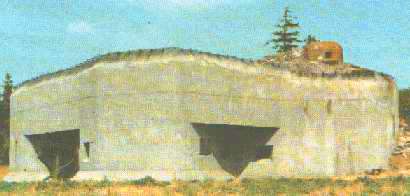 Photograph of the infantry blockhouse R-74. |
The Names of Forts:
The co-ordinating work on building huge numbers of heavy forts would be very difficult for ROP, so the defence line was divided into smaller independent sectors. Both the fortification works command and the building site guards were divided into the same sectors. The initial letter of the sector name was given to the name of the fort; therefore each heavy fort had its own unique number and usually its name as well.
For example: "N-S-85 Montace": "N" means that this fort was located in the sector Nachod; "S" is the initial letter of the Czech word "srub" (srub = blockhouse in English) and "Montace" was the code name of the fort. Usually the letter "S" was not written so "N-85 Montace" was the most common designation.
Bells:
The bells were cemented to the roof of forts. They were made of steel and enabled observation, close defence of the fort and signalling. Each bell ought to have been equipped with a periscope for observation. The bells had up to 6 embrasures for light machine-guns Mk. 26 or machine-guns Mk. 37. The bells could also be used for main weapons fire control during bad weather conditions or during the night. A 50 mm mortar was planned to be used in these bells but this weapon was not ready for use by 1938.
Another modification of these bells were observation bells being made especially of the fortress' artillery observation. They were made from the strongest steel and they had special additional internal armour in order to protect the observer from metal chips in case of a hit. These bells were planned to be equipped by special periscopes but they were not installed in reality. They had one or three small openings for observations.
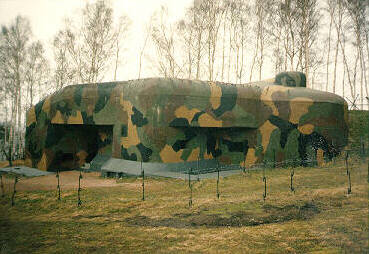 The N-S-82 "Brezinka" is the most impressive renovated heavy fort (resistance class II) between Beloves and the fortress Dobrosov. It was armed by an anti-tank gun 47 mm and six machine-guns. |
Cupolas:
Sometimes the main weapons could not be used in common embrasures in the concrete fort body (embrasures in the upper floor), e.g. in hilly areas. In such a case a special mounting for weapons M (twin machine-gun Mk. 37) or D (machine-gun Mk. 37) called a cupola was installed. Cupolas were not planned for observation or the fort defence like bells but for the main fire against the enemy. A cupola was a real compensation for weapons M or D in the concrete fort body.
Turrets:
No turrets could be installed in forts because only prototypes were under construction.
There were three main types of turrets - artillery, mortar and machine-gun turrets. All of them would have revolved 360 degrees and the artillery turret could also be elevated up to a height of about 70 cm above the roof of the fort before firing and then retract after firing. The machinery operating the turret would have been below the firing chamber. The turret would have been controlled either electrically or manually in case of an emergency.
1. The artillery turrets (code name F3V or 2YRO) consisted of two parts - a fixed steel collar that surrounded the turret and provided further protection (175 - 450 mm thick) and a revolving steel dome (350 mm thick) being equipped by two 10 cm howitzers and their gunners. Forts for these turrets were already built and uselessly expected their turrets. Forts for these turrets were always a part of fortresses and were never independent.
2. The mortar turrets (code name B12) also consisted of two parts like artillery ones but this turret could not elevate. It would have been equipped with two 12 cm mortars. In 1938 there were only plans of this turret and weapon and forts for this turret were also in the planning stage only. These forts were always planned as a part of fortresses as well.
3. The machine-gun turrets (code name OR) consisted like the other ones of two parts - one static and one revolving. This turret would have been used in forts having a good field of fire towards the enemy. They would have been equipped with weapon M (2 x machine-gun Mk. 37). Forts for these turrets were already built but there was only one prototype of the turret in 1938. These turrets ought to have been intalled in infantry blockhouses of resistance class III or in infantry blockhouses of fortresses (all blockhouses of fortresses had the resistance class IV).
Weapons:
| weapon | code name | calibre [mm] / [inch] |
range [m] |
rounds per minute | comments |
|---|---|---|---|---|---|
| light M.G. Mk. 26 | N | 7.92 / .312 | 200-1500 | 600 | Mk. = vz. (in Czech) |
| heavy M.G. Mk. 37 | D | 7.92 / .312 | 300-2500 | 550 | |
| twin M.G. Mk. 37 | M | 7.92 / .312 | 300-2500 | 2 x 550 | |
| 4 cm anti-tank gun + M.G. Mk. 37 |
L1 | 47 / 1.850 7.92 / .312 |
max. 5800 300-2500 |
35 550 |
|
| 4 cm gun | Q | 47 / 1.850 | max. 5800 | 35 | production ended after the introduction of L1 |
| 10 cm howitzer | Y | 100 / 3.937 | max. 11950 | 15-20 | never entered production |
| 5 cm mortar | U | 50.9 / 2.004 | 60-800 | 20 | never entered production |
| 9 cm mortar | G | 90 / 3.543 | 300-4400 | 25-30 | never entered production |
| 12 cm mortar | 120 / 4.724 | 250-7500 | 12 | never entered production |
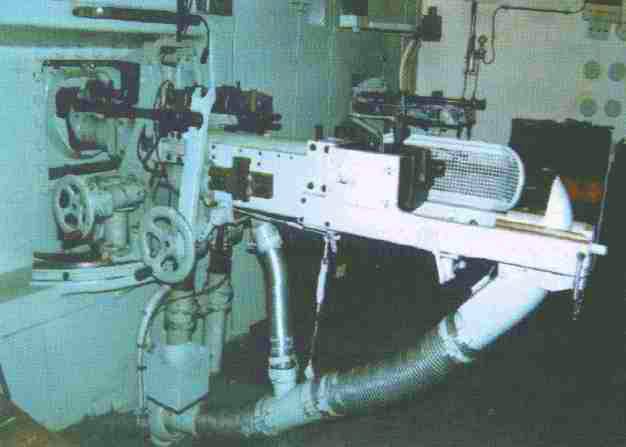 Weapon L1 (twin 47 mm anti-tank gun and M.G. Mk. 37) in right casemate of MO-19 "Alej" (in the back is the weapon M). |
Main weapons of each infantry blockhouse were in embrasures in the concrete fort body (for flank attacks) or in steel cupolas (for direct attacks). Weapons in casemates were L1, M, D, G (G in lower floor only). There were many combinations of weapons in each casemate and it depended on the location and tactical function of each blockhouse. Generally there were at least one embrasure for M and mostly three embrasures - two in the upper floor (e.g. L1 and M or M and D) and one embrasure for G in the lower floor. Each casemate of a blockhouse could have various combinations of weapons. Weapons in cupolas were M or D. Weapons (three Y) of artillery blockhouse were located in one big casemate that comprised the whole upper floor. There is one exception: K-45 has two embrasures in upper floor and one in lower because it was built on the side of a peak. Weapons for forts with artillery and mortar turrets were, of course, in turrets. Observation forts and entry blockhouses had no main weapons and used their weapons for their self-defence only. Almost every fort had some light machine-guns for close defence of embrasures and the entrance.
The infantry blockhouses were the most common blockhouses in comparison with other heavy forts; in fact one can say that all independent forts are blockhouses for infantry (there are only few exceptions: the observation forts). The most common one is the double-sided blockhouse with two bells, L1 (4.7 cm gun + machine-gun Mk. 37) and M (twin machine-gun Mk. 37) weapons in casemates on each side. This blockhouse had two floors. Embrasures with main weapons (L1, M) were always protected by light machine-guns Mk. 26. These machine-gunes were also in bells. A deep ditch in front of the main weapon embrasures protected them against attacks of enemy soldiers and assured that debris from any shelling did not obstruct the field of fire. These ditches are 2.1 m (resistance classes 1 and 2) or 3.1 m (I to IV) deep.
Design of a typical infantry blockhouse - upper floor (called the battle floor) is on the picture below.
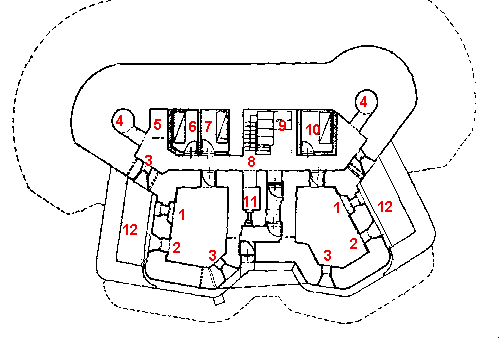 |
|
The lower floor usually consisted of quarters for soldiers, diesel generator, gas protection system, storage of ammunition, petrol and food, ground telegraph and a latrine. Upper and lower floor are connected by stairs in Class I, II, III, and IV forts. Floors in Class 1 and 2 forts are connected by a ladder.
There are some modifications in each fort; e.g. some forts near rivers do not have the lower floor and everything is situated on the upper floor. The upper floor is then larger.
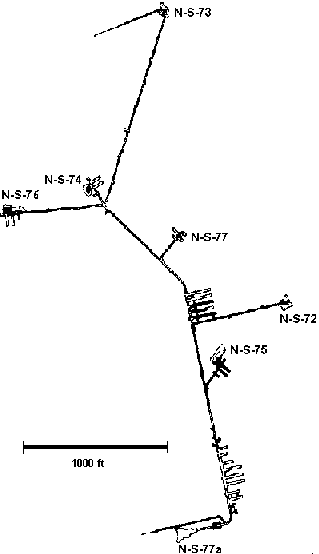
Fortresses were built usually on dominant peaks or hills. The distance between two fortresses was about 10 km or even closer in the most vulnerable areas. The neighbouring fortresses could get artillery support from each other because of a 11 km fire range of their 10 cm howitzer. Thirteen fortresses were planned to be built at the whole but only five were built completely (Smolkov, Hurka, Bouda, Adam, Hanicka) in 1938. Other four were in construction (Dobrosov, Skutina, Stachelberg, Sibenice - in the order of progress). A fortress consisted of several infantry blockhouses, one entry blockhouse, at least one fort for artillery turret, usually one artillery casemate (2 as a maximum) and in some cases a fort with one or two mortar turrets was planned. All blockhouses belonging to the fortress were connected by underground corridors and built in the highest resistance class - IV. Large ammunition stores, barracks, hospital, latrines, diesel generators, large gas protection system, kitchen, food storage, water tank, fortress HQ etc. were also located in the underground. Main corridors and corridors to artillery blockhouses were equipped with a small railway. Other corridors had an usual road.
The military power of fortresses was in fact very low in 1938 because neither the artillery turrets nor the howitzers in artillery casemates were installed. Lifts, generators and much other equipment were not installed, too.
On the picture (see left) is the fortress Dobrosov:
Entry blockhouse N-S-77a (never built).
Artillery casemates N-S-75 and N-S-76 (only N-S-75 was built).
Infantry blockhouses N-S-72 and N-S-73.
Fort for the artillery turret N-S-74 (never built).
Fort for the mortar turret N-S-77 (never built).
The space between both light and heavy forts was filled by obstacles against the infantry or anti-tank obstacles. The infantry obstacles were at least in two lines or alternatively in several lines in vulnerable locations. The anti-tank obstacles were always mixed with infantry obstacles and they were mostly deployed between blockhouses. In some location only the anti-tank obstacles were built between light forts.
The infantry obstacles (light) were made of barbed wire fixed to concrete steel poles (up to 115 cm) and they had up to six lines. They were used between light forts and combined with anti-tank obstacles.
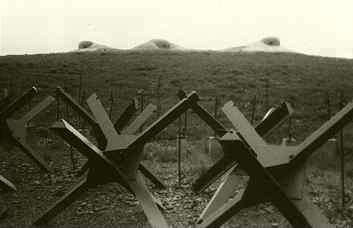 Anti-tank obstacles ("hedgehogs") in front of the fort MO-S-19 "Alej". |
The anti-tank obstacles (heavy) - there were several types of them. They were used sometimes between light forts but mainly between blockhouses. The most common was the type "A" which sustained of (in order towards enemy):
1. one strand of barbed wire fixed to concrete steel poles
2. one line of reinforced-concrete posts (130 cm)
3. one line of normal pins
4. one line of a special 6-armed iron obstacles called "hedgehog" (this obstacle was designed by Czech engineers and was widely used in WW2 by Germans and even now it is in use e.g. by Austria in order to a quick blocking of important roads in case of enemy attack). The action of the "hedgehog is as follows: A tank striking against one causes it to roll along in front of it while the obstacle slows up its advance and - under heavy anti-tank fire - the tank is brought to a standstill. The obstacles were chained together, so that an advancing tank would have to push a whole row of them in front of it.
Some blockhouses were supplied by a row of railway rails embedded close together in the ground. This row was in fact a lateral prolongation of each flanking wing wall in front of the main fire embrasures. These rails were naturally not able to stop a tank but prevented it from engaging the machine-gun embrasure before coming under fire of the anti-tank gun. The vertical rails masked the machine-gun embrasure from view and fire of the approaching tank until it came under view of the anti-tank embrasure (see e.g. blockhouse K-S-5 "U potoka", the shooting rooms).
Further modifications of anti-tank obstacles were other combinations of various lines (e.g. two lines of posts with two lines of poles, two lines of posts with two lines of "hedgehogs" etc.) A special obstacle was an anti-tank ditch which was 2 m deep and about 5 m wide. The ditch side facing the enemy was made of reinforced concrete being between 20 to 40 cm thick. This obstacle was built mainly in front of casemates to secure a good field of fire which could be reduced by wrecks of destroyed enemy tanks.
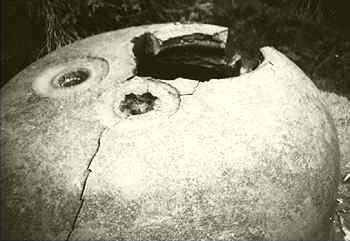 Bell damaged by German tests. |
After Germany occupied the Czech Republic (Slovakia closed a coalition with the Nazi Germany), the German army tested the resistance of the forts. Many blockhouses were damaged by firing trials. Some blockhouse bells were tested by special weapons which were later used during the attack at Eben Emael. Some steel components were removed from the blockhouses and were used in the Atlantic Wall (weapon L1 and its embrasures). Some blockhouses near Ostrava and Opava were used during the end of WW2 by German units against the approaching Red Army.
The communists ripped out and scrapped remaining steel bells, cupolas and embrasures during the fiftieth. Only a few of undamaged blockhouses remained - mainly near civilian houses which could have been damaged by an explosion. Many blockhouses were used as storage places for waste by the communists. All fortresses became military stores or bases (except "Bouda").
All light forts in the Protectorate of Bohemia-Moravia were destroyed by the Germans.
Nowadays there are few museums but majority of blockhouses and light forts are in a very bad condition and sometimes it is quite difficult to find even a blockhouse in impenetrable woods.
05738 |
 |
Updated: 22nd February 2011. Music: Bedrich Smetana - My Country, Tabor. MIDI file sequenced by Petr Cvikl. |
K-S-5 |